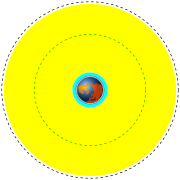Various earth orbits to scale; cyan represents low earth orbit, yellow represents medium earth orbit, the black dashed line represents geosynchronous orbit, the green dash-dot line the orbit of Global Positioning System (GPS) satellites, and the red dotted line the orbit of the International Space Station (ISS).
Centric classifications
- Galactocentric orbit: An orbit about the center of a galaxy. Earth's sun follows this type of orbit about the galactic center of the Milky Way.
- Heliocentric orbit: An orbit around the Sun. In our Solar System, all planets, comets, and asteroids are in such orbits, as are many artificial satellites and pieces of space debris. Moons by contrast are not in a heliocentric orbit but rather orbit their parent planet.
- Geocentric orbit: An orbit around the planet Earth, such as the Moon or artificial satellites.Currently there are approximately 2465 artificial satellites orbiting the Earth.
- Areocentric orbit: An orbit around the planet Mars, such as moons or artificial satellites.
Altitude classifications
- Low Earth Orbit (LEO): Geocentric orbits ranging in altitude from 0–2000 km (0–1240 miles)
- Medium Earth Orbit (MEO): Geocentric orbits ranging in altitude from 2000 km (1240 miles) to just below geosynchronous orbit at 35786 km (22240 miles). Also known as an intermediate circular orbit.
- High Earth Orbit (HEO): Geocentric orbits above the altitude of geosynchronous orbit 35786 km (22240 miles).
Inclination classifications
Inclined orbit: An orbit whose inclination in reference to the equatorial plane is not zero degrees.
Polar orbit: An orbit that passes above or nearly above both poles of the planet on each revolution. Therefore it has an inclination of (or very close to) 90 degrees.
Polar sun synchronous orbit: A nearly polar orbit that passes the equator at the same local time on every pass. Useful for image taking satellites because shadows will be nearly the same on every pass.
Eccentricity classifications
Circular orbit: An orbit that has an eccentricity of 0 and whose path traces a circle.
Hohmann transfer orbit: An orbital maneuver that moves a spacecraft from one circular orbit to another using two engine impulses. This maneuver was named after Walter Hohmann.
Elliptic orbit: An orbit with an eccentricity greater than 0 and less than 1 whose orbit traces the path of an ellipse.
Geosynchronous transfer orbit: An elliptic orbit where the perigee is at the altitude of a Low Earth Orbit (LEO) and the apogee at the altitude of a geosynchronous orbit.
Geostationary transfer orbit: An elliptic orbit where the perigee is at the altitude of a Low Earth Orbit (LEO) and the apogee at the altitude of a geostationary orbit.
Molniya orbit: A highly elliptic orbit with inclination of 63.4° and orbital period of half of a sidereal day (roughly 12 hours). Such a satellite spends most of its time over a designated area of the planet.
Tundra orbit: A highly elliptic orbit with inclination of 63.4° and orbital period of one sidereal day (roughly 24 hours). Such a satellite spends most of its time over a designated area of the planet.
Hyperbolic orbit: An orbit with the eccentricity greater than 1. Such an orbit also has a velocity in excess of the escape velocity and as such, will escape the gravitational pull of the planet and continue to travel infinitely.
-Parabolic orbit: An orbit with the eccentricity equal to 1. Such an orbit also has a velocity equal to the escape velocity and therefore will escape the gravitational pull of the planet and travel until its velocity relative to the planet is 0. If the speed of such an orbit is increased it will become a hyperbolic orbit.
Escape orbit (EO): A high-speed parabolic orbit where the object has escape velocity and is moving away from the planet.
Capture orbit: A high-speed parabolic orbit where the object has escape velocity and is moving toward the planet.
Synchronous classifications
Synchronous orbit: An orbit where the satellite has an orbital period equal to the average rotational period (earth's is: 23 hours, 56 minutes, 4,091 seconds) of the body being orbited and in the same direction of rotation as that body. To a ground observer such a satellite would trace an analemma (figure 8) in the sky.
Semi-synchronous orbit (SSO): An orbit with an altitude of approximately 20200 km (12544.2 miles) and an orbital period of approximately 12 hours
Geosynchronous orbit (GEO): Orbits with an altitude of approximately 35786 km (22240 miles). Such a satellite would trace an analemma (figure 8) in the sky.
Geostationary orbit (GSO): A geosynchronous orbit with an inclination of zero. To an observer on the ground this satellite would appear as a fixed point in the sky.[10]
Clarke orbit: Another name for a geostationary orbit. Named after the writer Arthur C. Clarke.
Supersynchronous orbit: A disposal / storage orbit above GSO/GEO. Satellites will drift west. Also a synonym for Disposal orbit.
Subsynchronous orbit: A drift orbit close to but below GSO/GEO. Satellites will drift east.
Graveyard orbit: An orbit a few hundred kilometers above geosynchronous that satellites are moved into at the end of their operation.
Disposal orbit: A synonym for graveyard orbit.
Junk orbit: A synonym for graveyard orbit.
Areosynchronous orbit: A synchronous orbit around the planet Mars with an orbital period equal in length to Mars' sidereal day, 24,6229 hours.
Areostationary orbit (ASO): A circular areosynchronous orbit on the equatorial plane and about 17000 km(10557 miles) above the surface. To an observer on the ground this satellite would appear as a fixed point in the sky.
Heliosynchronous orbit: An heliocentric orbit about the Sun where the satellite's orbital period matches the Sun's period of rotation. These orbits occur at a radius of 24,360 Gm (0,1628 AU) around the Sun, a little less than half of the orbital radius of Mercury.
Special classifications
Sun-synchronous orbit: An orbit which combines altitude and inclination in such a way that the satellite passes over any given point of the planets's surface at the same local solar time. Such an orbit can place a satellite in constant sunlight and is useful for imaging, spy, and weather satellites.
Moon orbit: The orbital characteristics of earth's moon. Average altitude of 384403 kilometres (238857 mi), elliptical-inclined orbit.
Pseudo-orbit classifications
Horseshoe orbit: An orbit that appears to a ground observer to be orbiting a certain planet but is actually in co-orbit with the planet. See asteroids 3753 (Cruithne) and 2002 AA29.
Exo-orbit: A maneuver where a spacecraft approaches the height of orbit but lacks the velocity to sustain it.
Orbital spaceflight: A synonym for exo-orbit.
Lunar transfer orbit (LTO)
Prograde orbit: An orbit with an inclination of less than 90°. Or rather, an orbit that is in the same direction as the rotation of the primary.
Retrograde orbit: An orbit with an inclination of more than 90°. Or rather, an orbit counter to the direction of rotation of the planet. Apart from those in sun-synchronous orbit, few satellites are launched into retrograde orbit because the quantity of fuel required to launch them is much greater than for a prograde orbit. This is because when the rocket starts out on the ground, it already has an eastward component of velocity equal to the rotational velocity of the planet at its launch latitude.
Halo orbit and Lissajous orbit: Orbits "around" Lagrangian points.
Retrieved from 'http://en.wikipedia.org/wiki/Satellite'
Version 1.2, November 2002 Copyright (C) 2000,2001,2002Free Software Foundation, Inc. 51 Franklin St, Fifth Floor,Boston, MA 02110-1301 USA Everyone is permitted to copy anddistribute verbatim copies of this license document, but changingit is not allowed.



































![Validate my RSS feed [Valid RSS]](valid-rss.png)



thanks info